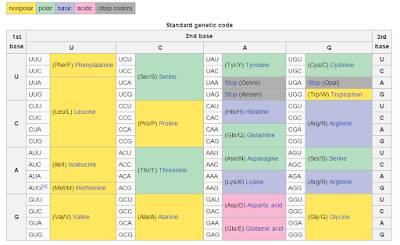16 Ekim 2015 Cuma
Amino acid composition and effects of mutations
That's pretty clear, isn't it? Just kidding, I have NO idea what that is, but its a figure from this paper, that does actually make a lot of sense.
Here is the gist of it: mutations are gonna happen. If they didn't evolution, to a large degree, wouldn't happen either (hugely complicated higher organism silly reproductive procedures aside). What Sahand Hormoz is proposing here is that the evolutionary pressure on essential proteins and their structures is to minimize the nasty effects of mutations is a mathematical certainty. That's a long sentence and I think the grammar could use some work.
Here, I've stolen the genetic coding table from this Wikipedia page. Say, you've got an essential leucine at this essential location. That's great! Cause many point mutations can happen to the section of the DNA and the protein won't change at all! You can change UUA to UUG or CUA and you're still gonna have leucine! Now, if it goes UAA...well you've got a truncated protein...so maybe this wasn't the best example.
There are also changes where we switch amino acids and it isn't all that bad either. For example, it would be better to have a mutation that changes a polar amino acid with a small functional group to another similar one, but changing to one with a huge non-polar, would be a whole lot worse.
From the genetic perspective, this makes all sorts of sense. What this guy did was show that you can calculate it with that Maths stuff to show that this wasn't accidental at all. This was evolutionary pressure over billions of years to find the best possible way to protect the proteins that life would end without. Really cool read, even if you don't know what any of the equations mean!
Kaydol:
Kayıt Yorumları (Atom)
Popular Posts
-
A recent paper in PNAS makes the statement in the title "Protein Carbamylation is a Hallmark of Aging. You can find it here . They find...



Hiç yorum yok:
Yorum Gönder